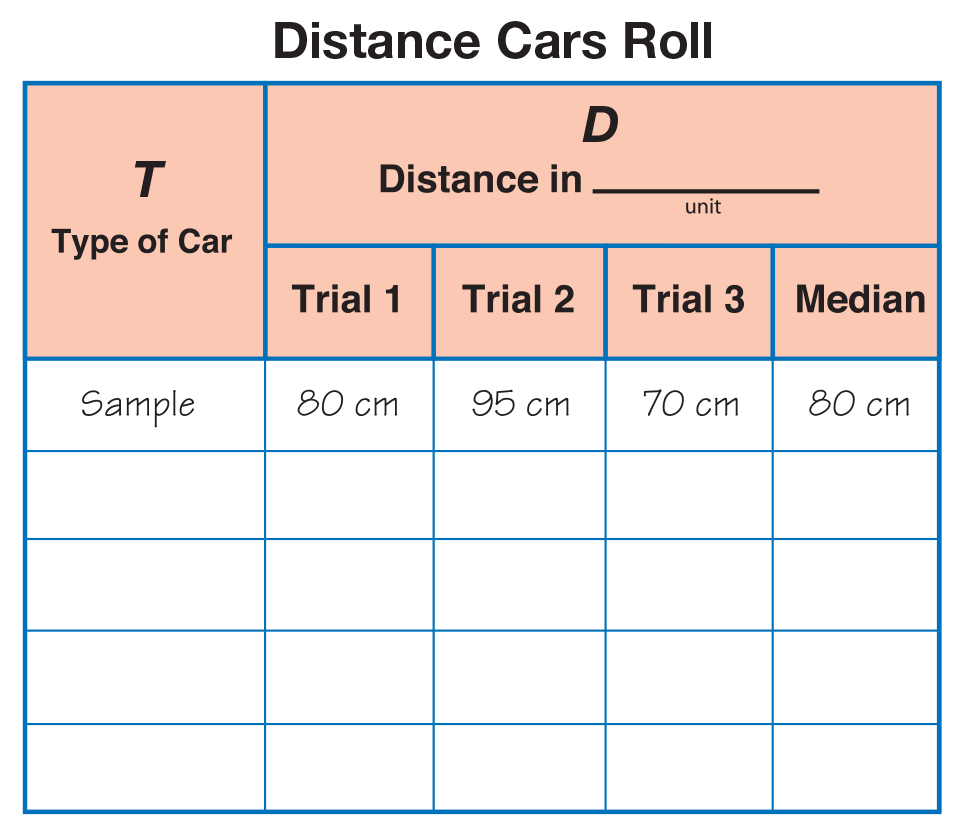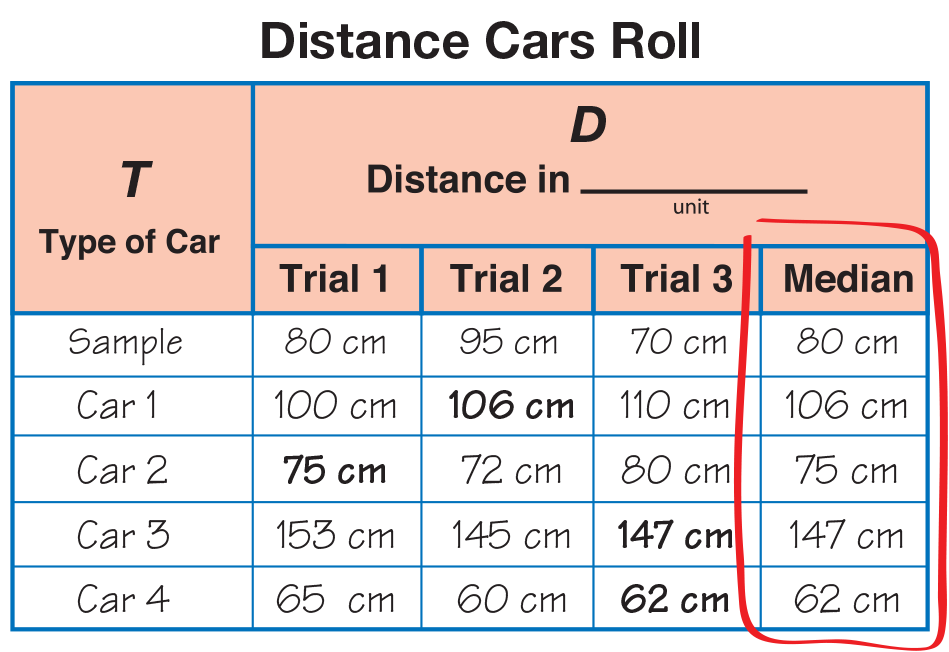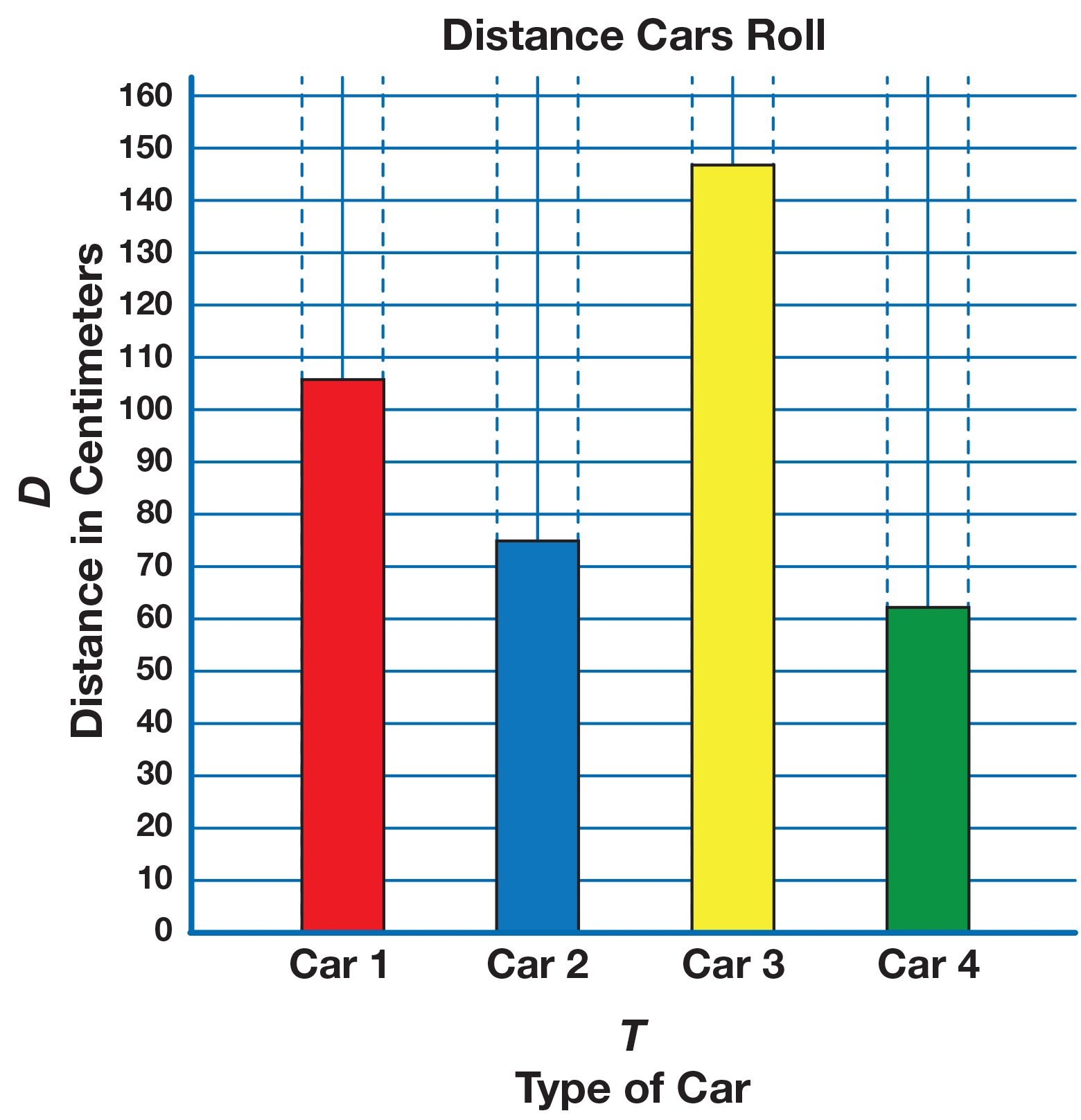Find and Record the Median. After data collection
is complete, engage students in a discussion about
why a median value is used.
- I see that many of your data tables show that the
cars did not roll the same distance for each of the
three rolls. Why do you think this happens? (Answers will vary. Allow students to speculate.)
Explain that many things can affect the distance the
cars roll and this normal variation is expected. Help
students understand that scientists address this by
making multiple trials and then determining the representative,
or average, values for the data.
- If scientists and engineers were testing the cars,
they would roll each car more than one time. They
would conduct several trials as we did. Why do
you think it is a good idea to try the cars more
than once? (Possible response: The scientists
want to be sure they don't make any mistakes.)
- Rather than using measurements from all three trials
scientists use a single value called the median
to represent all three trials. Why do you think scientists
use just one measurement? (Possible
response: Maybe there's too many numbers to
keep track of. If they have so many cars and try
each one many times, that's a lot!)
- Scientists use the median, or middle distance,
rather than the longest or shortest distance. Why
would it be a good idea to use the median distance? (Possible response: You could get a really
long roll or a really short one and the middle is
best. It is more normal, not too long and not too
short.)
Conclude that the middle value is a good representation
of how far the car rolls since it is neither the
shortest nor the longest distance.
Introduce median using the sample data collected in
Part 2 on the display of the data table. With the help
of the students, order the measurements from smallest
to largest. Ask students to determine the middle
value. When arranged sequentially, the median is the
middle measurement. Record the median in the
appropriate column on the display. See Figure 6. Ask
students to find the median for their own data. They
might use a number line or cross out the high and
low measurements.
The word median is a new mathematics word, but some
children might know about the median strip on the highway,
a stripe or barrier down the middle of the road.
The everyday meaning of "average" is slightly different
from the mathematical meaning. In ordinary English,
average usually means the add-up-all-the-numbers-and-divide
average that we learned in school. Mathematicians
call this number the "mean." Mathematicians also recognize
other averages, or measures of central tendency. One type
of average accessible to young students is the median, or
middle value of a set of ordered values. Second-graders can
understand the middle value in terms of being the "fairest"
among several trials. Three trials were specifically used in
this experiment because it makes finding the median easy.
Check to see that students have not confused the
median with Trial 2. Sometimes the median might
occur in the second trial; however, this will not
always be the case. If students have difficulty identifying
the median, list some measurements in groups
of three on the board. Use a number line or the 200
Chart to help students identify the median for each
group of three. Have students draw a box around the
median column on their data table with a crayon or
colored pencil so they will not be confused about
which measurement to graph. See Figure 7.
If using a number line or 200 Chart to order the
measurements, circle the three measurements when placed
on the line or chart. Ask which of the three numbers is in the
middle.
Graph the Median. Have students compare their
completed data tables to a display of the empty
graph in Question 6 of the Student Activity Book.
Discussion should include:
- a title and labels for each axis on the graph is
needed;
- values for each bar along the horizontal axis
should be written (colors—red car, blue car, etc. or
numbers—car #1, car #2, etc.);
- deciding with students how to number the vertical
axis (by fives or tens depending on the distances
their cars rolled);
- demonstration of what to do if the distances fall
between two numbers on the vertical axis.
Have students work independently to complete their
graphs then share their results with the class. See
Figure 8.
If students need to review labeling a graph, ask a student
volunteer to do his or her graph on a display prior to having
students work individually.
Use Question 6 on the Rolling Along with Centimeters pages
in the Student Activity Book to assess students' abilities to
make bar graphs [E8]. Note whether students use
appropriate labels in the correct places and scale bars to the
correct height, including those that land between horizontal
axes.



















